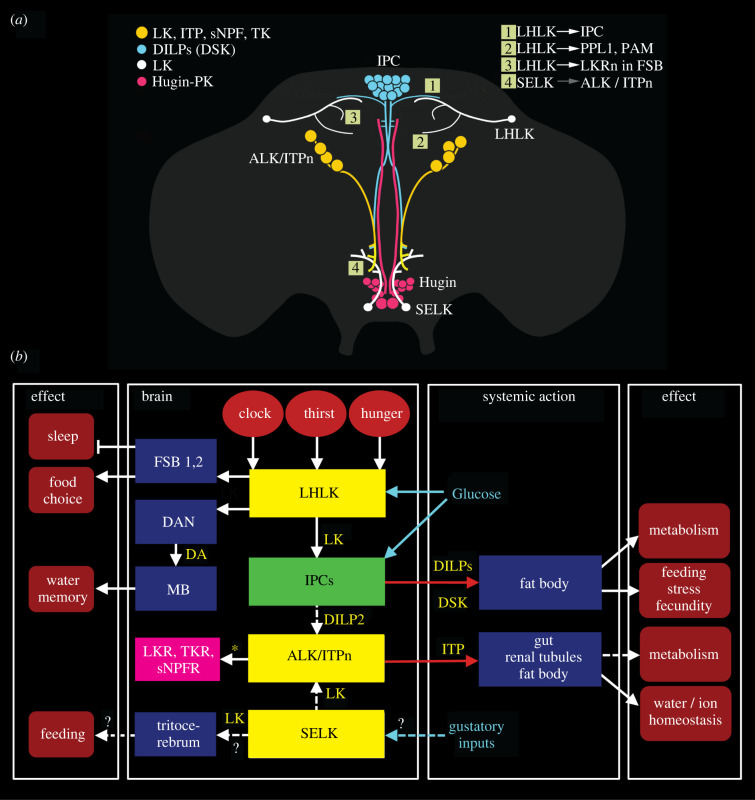Figure 4.
Context-specific signalling, exemplified by neurons signalling with leucokinin (LK). (a) Schematic depiction of LK neurons in relation to some neurosecretory cells in the adult Drosophila brain. The LHLKs act on (white arrows) insulin (DILP) producing cells (IPCs), dopaminergic neurons (PPL1 and PAM subtypes) and at least two types of LK receptor (LKR)-expressing neurons (LKRn; FSB 1 and 2; see (b)) innervating the FSB. SELKs may act (grey arrow) on the ALK/ITPn that express the LKR. The Hugin neurons of the suboesophageal zone are shown since they form a link between gustatory sensory cells and feeding circuits, including IPCs. The numbered boxes (1–4) indicate sites of interaction between neurons. Data derived from [9,93,94,172,173]. (b) Schematic diagram of functional connections between LK neurons (yellow boxes) and other neurons, circuits and peripheral targets. Arrows indicate various actions, dashed arrows (and ?) suggest actions yet to be confirmed, and stop bars indicate inhibitory action. The LK neurons in the brain are shown as yellow boxes and the IPCs as a green box. Targets of LK signalling are shown as dark blue boxes. LHLKs signal to two types of LKR expressing neurons of the fan-shaped body (FSB 1, 2; these are LKR neurons and FBl6 neurons), and via dopaminergic neurons (DAN) to mushroom body-associated neurons (MB). The LKR-expressing FSB neurons inhibit sleep [172] and the FBl6 neurons regulate food choice [9], whereas the MB neurons, via dopamine (DA) inputs, mediate water (and sugar) memory [34]. LHLKs respond to decreased glucose and receive inputs from neuronal circuits of the circadian clock and systems sensing thirst and hunger (red ellipses). LHLKs signal with LK to IPCs, which regulates sleep–metabolism interactions [93,94]. IPCs are nutrient-sensing and use DILPs to regulate multiple functions, including carbohydrate and lipid metabolism, feeding, stress responses and fecundity; IPCs also express drosulfakinin, DSK (see [174]). IPCs are likely to act on the ALK/ITPn with DILP2 (dashed arrow) (see [175]). SELK neurons may receive gustatory inputs [171], but their actions are not functionally confirmed (dashed arrows and ?). The ALK/ITPn are neurosecretory cells that use ion transport peptide (ITP) to systemically regulate water homeostasis via the intestine and hindgut and also to regulate feeding and drinking [102]. These cells also use tachykinin (TK) and short neuropeptide F (sNPF) to regulate responses to starvation and desiccation [101], probably by paracrine signalling (asterisk), but the neuronal circuitry is not yet known. The magenta box represents neurons expressing receptors for LK, TK and sNPF (and ITP; not shown) in the brain that are yet to be identified. The role of LK in ALK/ITPn cells is not yet known. (b) is updated and modified from Nässel [176].

